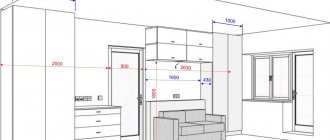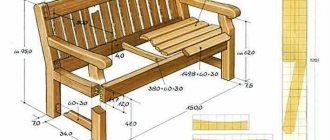A rectangular table is a fairly simple design. If desired, it can be made by a novice amateur carpenter. This does not require special skills, but there are types of tables with complex designs.
Before you get down to business, it’s worth looking at photos of handmade tables. When the model is presented in your head from different sides, then things will go much faster.
The benefits of creating a workbench with your own hands
Not every owner believes that a workbench is constantly needed on the farm: it is needed only during repairs or reconstruction of the building, so he prefers to rent it. But such an opinion is erroneous, especially if he is the owner of a household located on the ground. The carpentry workbench that appeared on the farm will be a real help for him. Having made such a design, the owner receives a number of advantages compared to using a workbench rented or purchased at a construction supermarket.
- He will save a significant amount of money, which he can use for further improvement of the house.
- Will gain additional management experience and practical skills.
- You will have at your disposal a comfortable work table suitable for processing parts made of wood and metal.
- If the owner makes a workbench with his own hands, he can use it at any time.
Therefore, in one room (it’s good if there is a basement) it is necessary to place shelving and a workplace.
Modern instruments
Of the automated devices, it is recommended to use the following:
- Instead of a hand saw, it is good to use an electric jigsaw;
- The sandpaper was replaced by a sanding machine. It will significantly reduce the wood processing time;
- Using a milling machine, you can round any corner of a tree and make different shaped grooves;
- A screwdriver replaced screwdrivers. It will eliminate the tedious task of screwing in screws and self-tapping screws. It is also capable of replacing a drill, it all depends on the model of the device;
- A modern measuring device is a level. Its use will make the table level.
Read here: Do-it-yourself fence - step-by-step instructions for construction and installation (85 photo ideas)
Types of tables
There are various types of workbenches that have different purposes.
- Carpentry workbench for making wooden parts. It is convenient to process small wooden products, but is not intended for primary wood processing. It will require a tabletop three meters long and one meter wide. The parts on it are secured with wooden horizontal and vertical clamps.
- The carpenter's jig is significantly larger in all respects and heavier. Tree trunks are processed on it, boards, beams and other wood blanks are cut.
- The universal table allows you to work with wood and metal; its tabletop is reinforced with metal tape and has wooden and metal clamps.
There is a table for carrying out metalwork and car maintenance in almost every garage.
There is another definition of types of structures based on possible location.
- Mobile (portable). Used to perform minor work with small parts. It is comfortable and quite light. It can be moved from one place to another without much difficulty. The carpenter's table is equipped with a small or medium-sized vice, which allows it to be used for minor metalwork work.
- The stationary desktop is massive and stable. You can use it to process lumber, but a home craftsman will hardly need such a workbench unless he constantly engages in woodworking.
- Prefabricated with connections using bolts. This is a kind of transformer: at any time it can be supplemented with special equipment and the necessary changes can be made, depending on the tasks being solved.
And as a rule, it is homemade, that is, it is made taking into account the characteristics of a particular room.
What type of construction a home master chooses directly depends on what goals and objectives he sets:
- a work table is needed for processing small parts and manufacturing small products only for the period of repair and construction work;
- the owner will constantly use it and work with small volumes of wooden parts;
- a workbench will be needed to carry out primary processing of wood, turning it into boards and timber on an ongoing basis;
- The table is intended to be used for periodic processing of small wooden and metal parts.
The shape and dimensions are determined by the configuration of the room.
Experienced home craftsmen claim that even a novice owner who has no skills in handling metalwork tools can make the product.
A workbench for a garage is often compared to a desk because it provides convenience for a variety of tasks and makes it possible to keep all the necessary tools at hand.
Material selection
To make a workbench with your own hands, a craftsman needs wood and metal. If you plan to make a small table, then a wooden base will be suitable for it. For the tabletop, laminated chipboard or pressed plywood with a thickness of at least 5–7 cm is suitable. For a stationary table, you can use well-planed boards, tightly fitted to each other, and partially metal.
In addition to the tabletop, it has a large number of shelves and drawers.
And if a home craftsman has an unnecessary desk at his disposal, then it will become a good basis. It is also convenient because it already has several drawers or compartments for storing tools.
The driver's workplace must be strong and stable.
An old solid door door can be used in the design. It will make a wonderful, durable tabletop that doesn’t even require processing.
Under the table there must be cabinets with tools and consumables (drills, hacksaw blades, rags, etc.).
Using available materials on the farm to make a carpentry table with your own hands will save the home craftsman time and money.
It is irrational to make a monolithic cabinet out of a table; you need somewhere to put your feet during sedentary work.
You can make your own workbench out of metal. It will be strong, reliable and heavy. But experience shows that the most acceptable is an intermediate option, when the frame and cover of the workbench are made of wood and then covered with sheet metal.
However, both sides should be, if not sets of drawers, then at least a set of shelves.
A home craftsman who decides to make a workbench with his own hands will need a certain set of materials. He knows well what is needed for this.
The workbench in the garage should not be part of the rack, therefore, the wall above it is a place for hanging tools.
And for those who do not yet have sufficient experience, we have compiled a list of everything necessary for its manufacture:
- metal corner;
- steel strip and galvanized iron sheet;
- plywood;
- screws;
- anchor bolts;
- square pipe;
- wooden boards;
- metal screws;
- dye.
Both metal and wooden workbench have the right to life.
Choice of modification
Among the variety of models of multifunctional furniture, tables are in particular demand. They are presented in various modifications and forms. According to their purpose they are divided into:
- For magazine work. With the help of a special tabletop and a smooth transformation mechanism, an ordinary table can easily be turned into a work desk, reminiscent of a school desk. The fastening system is designed for several different positions, allowing you to take the desired height. The furniture is equipped with convenient drawers for storing books and stationery.
- Dinner-magazine. This is the most common option, indispensable for small spaces that do not have a separate dining room. It stays folded most of the time and takes up little space. But when guests come, it can be easily expanded to create a full-fledged dining table that can accommodate up to ten people.
- Storage table. Compact design that hides storage space for household items from prying eyes. Consists of a table top and several drawers underneath. Once assembled, access to them is blocked. It opens if you rotate the tabletop around its axis.
- Picnic table. Has many modifications. This is the most common item that is most often made by hand. The tabletop can be rotary, round or rectangular. It is attached to frames that make it easy to move the structure into the desired position.
Making transformable tables with your own hands is not at all difficult. Without any skills, you can start with a picnic product. It has the simplest assembly scheme; any material will do. And after practicing, you can proceed to more complex furnishings. At the same time, choose a design that you really like, and not the one presented in the store.
DIY table decoupage instructions for beginners
Journal-worker
Lunch-magazine
Storage table
For a picnic
What tools will you need?
A self-made small wooden carpentry workbench will take its rightful place in a home workshop. You don't need a lot of tools to make it.
You can always put a piece of plywood or hardboard on a steel sheet, and a galvanized sheet on a wooden surface.
You will need a standard set that can be found in every home:
- screwdriver;
- roulette;
- Bulgarian;
- jigsaw or hand saw;
- hammer.
First of all, we determine the ergonomics of the workplace.
Depending on what material will be used for the carpentry workbench, the list of materials and tools may vary. For example, to make a metal work table, you cannot do without a welding machine and electrodes.
The height of the workbench should be such that you don’t have to bend your back and, at the same time, stand on tiptoes.
Manufacturing instructions
To make a transformable folding table from wood you will need:
- make a drawing;
- prepare details;
- choose a mechanism for the table;
- perform assembly.
Step-by-step restoration of an old table, ideas for original decoration
The instructions for all parts indicate universal sizes. Individual assembly diagrams for transformer tables may contain other numbers. Calculations vary depending on the design of the product and its dimensions.
Drawing up a drawing
You can make drawings and diagrams for making a transformer table yourself by drawing a sketch on paper with all sizes marked. The sizes can be selected individually, or you can use universal options:
- When assembled, 90 by 75 by 51 cm (length, width, height).
- Unassembled 90, 150, 51 cm.
Calculations must be accurate; every wrong millimeter can lead to the failure of the entire product. Therefore, it is much more convenient and easier to make moss using a special computer program. In it you can not only draw a layout of the future table, but also calculate the materials and create a cutting map. It is quite easy to learn. In a couple of days you can draw a high-quality drawing and avoid possible mistakes.
Preparing parts
To make a real transformer with your own hands instead of a regular table, you will need the following parts:
- Chipboard 2.2 cm thick, size 90 by 60 cm, two pieces for the tabletop.
- One sheet measuring 72 x 35 cm as an auxiliary panel.
- Four furniture corners.
- Four bars 51 cm high for supports.
- Transformation mechanism.
- Accessories: screws, bolts, nuts, washers, hinges.
To assemble the product you will need a screwdriver, hammer, jigsaw or electric saw.
Assembly
Assembly is an important stage in the manufacture of a transformer table using a lifting mechanism with your own hands. When all the drawings, tools and materials are prepared, you can proceed:
- Carefully and carefully cut out all the planned details. The ease of unfolding the product will depend on the accuracy of the cut.
- Using an eccentric tie, connect the legs together. This will further strengthen the finished furniture and add stability to it.
- Make markings to secure the transformation mechanism.
- Drill through holes and attach fastening parts to them.
- Next, secure the tabletop to the holder platform using the corners; it is better to start fixing it from the smaller panel.
After this, all that remains is to fold and unfold the structure several times to make sure that the assembly is done efficiently and all parts are securely fastened.
Assembly diagram
Assemble the legs
Strengthen the frame with legs
Install transformation mechanism
Attach fastening parts to them
Secure the tabletop
Ready product
Where to put it?
Before starting work, it is important to immediately determine what and how often the table will be used and where it will be placed. You can’t do without a drawing. The answers to these questions will determine its size, material and manufacturing procedure.
We advise you to take a closer look at the countertop in your wife’s kitchen.
The best place to place the device can be considered that part of the room (garage or shed) where there is natural light. It is also important to have electrical outlets near your workbench to plug in power tools and a lamp. It is best if the light falls from the left or directly, then the working surface of the table will be illuminated during the day.
Design the dimensions of your work area.
Then the parameters of the future design are determined. Despite the existing standards regarding the size of the table, if you make a carpentry workbench with your own hands, the home craftsman will proceed from the expediency and actually available space, so the tabletop will be such that tools and parts can be freely placed here, without strict adherence to dimensions. The width is usually 50-60 cm; this size is considered optimal, as it allows you to freely reach the opposite edge of the tabletop.
The typical vertical table size is in the range of 850-950 mm.
Another important parameter is the height of the workbench. There are various ways to determine it, ranging from precise mathematical calculations to folk experience, which suggests that the optimal indicator is the distance from the extreme point of the arm bent at the elbow to the floor. An experienced craftsman can make it adjustable.
A perforated metal sheet is ideal as a wall for placing tools.
After determining the basic parameters of the product, you can begin assembly.
- First, the legs are fixed (four supports made of steel angles, which are also connected by angles and secured by welding at the top and bottom.). The result is a rectangular welded structure.
- After making the frame, they begin to prepare the tabletop. Boards cut to size are laid out on top of the frame and fastened tightly together. The tabletop is connected to the frame using bolts. The working surface must be processed: planed and sanded. The bottom must be secured with crossbars or wooden blocks. They are screwed to each of the elements of the resulting shield.
After securing it, you need to cover the lid with metal (it is better if it is galvanized). The metal sheet is fixed to the surface of the tabletop with self-tapping screws. If burrs form, they must be cleaned off.
The workpieces should be cut before welding begins.
The main work on making the workbench is completed here, but to give greater rigidity to the structure and attach it to the floor, you can weld metal corners from below. If desired, it can be equipped with drawers and shelves for tools.
We reinforce all welded joints with a corner or steel strip.
Among the necessary equipment on the workbench, a vice must definitely find a place. They are hung on the front side of the tabletop and are used for fastening products. If you often work on large parts, there is a need to install several vices of different sizes.
The main thing is to strengthen all 90° connections.
You can mount shelves under the workbench where you can place various devices, the necessary tools, or store processed parts.
Be sure to impregnate the wood with antiseptic and fire-retardant impregnation.
Carefully made with your own hands, a carpentry workbench will become a convenient tool for the work of a home craftsman.
This design is close to the ideal of a DIY garage workbench.










